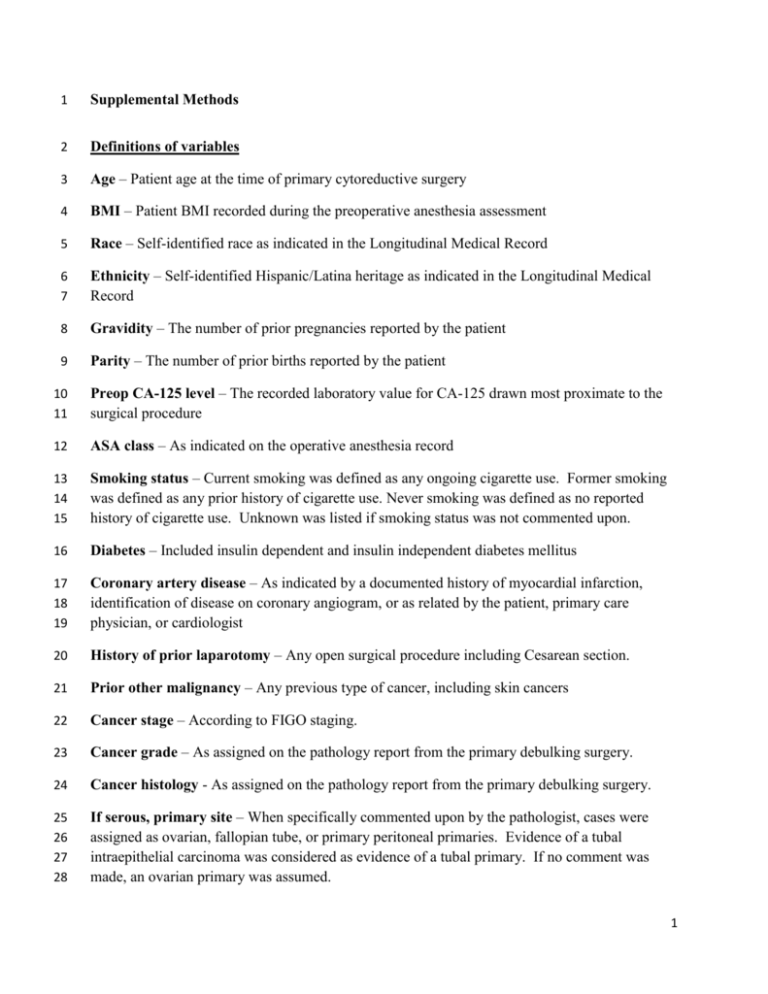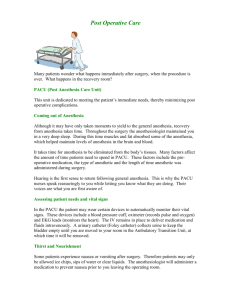Supplemental Methods Definitions of variables Age – Patient age at
advertisement

1 Supplemental Methods 2 Definitions of variables 3 Age – Patient age at the time of primary cytoreductive surgery 4 BMI – Patient BMI recorded during the preoperative anesthesia assessment 5 Race – Self-identified race as indicated in the Longitudinal Medical Record 6 7 Ethnicity – Self-identified Hispanic/Latina heritage as indicated in the Longitudinal Medical Record 8 Gravidity – The number of prior pregnancies reported by the patient 9 Parity – The number of prior births reported by the patient 10 11 Preop CA-125 level – The recorded laboratory value for CA-125 drawn most proximate to the surgical procedure 12 ASA class – As indicated on the operative anesthesia record 13 14 15 Smoking status – Current smoking was defined as any ongoing cigarette use. Former smoking was defined as any prior history of cigarette use. Never smoking was defined as no reported history of cigarette use. Unknown was listed if smoking status was not commented upon. 16 Diabetes – Included insulin dependent and insulin independent diabetes mellitus 17 18 19 Coronary artery disease – As indicated by a documented history of myocardial infarction, identification of disease on coronary angiogram, or as related by the patient, primary care physician, or cardiologist 20 History of prior laparotomy – Any open surgical procedure including Cesarean section. 21 Prior other malignancy – Any previous type of cancer, including skin cancers 22 Cancer stage – According to FIGO staging. 23 Cancer grade – As assigned on the pathology report from the primary debulking surgery. 24 Cancer histology - As assigned on the pathology report from the primary debulking surgery. 25 26 27 28 If serous, primary site – When specifically commented upon by the pathologist, cases were assigned as ovarian, fallopian tube, or primary peritoneal primaries. Evidence of a tubal intraepithelial carcinoma was considered as evidence of a tubal primary. If no comment was made, an ovarian primary was assumed. 1 29 Level of surgical debulking – As indicated in the dictated operative note. 30 31 32 33 34 Surgical Complexity Score – Based on a points system modified from Aletti, et al. Six or fewer points was considered low complexity, seven to ten points medium complexity, and greater than ten points high complexity. As an example, an exploratory laparotomy, total abdominal hysterectomy, bilateral salpingo-oophorectomy, omentectomy, and cytoreduction surgery would be assigned five points. Points were assigned as follows: 35 Exploratory laparotomy (1) 36 Total abdominal hysterectomy (1) 37 Bilateral or unilateral salpingo-oophorectomy (1) 38 Omentectomy (1) 39 Appendectomy (1) 40 Placement of intraperitoneal port (1) 41 Small bowel resection (1) 42 Lymph node dissection (1) 43 Pelvic lymphadenectomy (1) 44 Paraaortic lymphadenectomy (1) 45 Cytoreductive surgery (Removal of tumor implants) (1) 46 Large bowel resection (2) 47 Splenectomy (2) 48 Diaphragm stripping/resection (2) 49 Liver resection (3) 50 Low anterior resection with reanastamosis (3) 51 52 Estimated blood loss – As indicated in the dictated operative note. If the estimated blood loss was not dictated, the quantity estimated by the anesthesiologist was used. 53 Length of case – Recorded from skin incision to surgery end. 54 Units of blood transfused intraop – As recorded by the operative anesthesia record. 55 Length of hospital stay – Recorded from the day of surgery to the day of discharge. 2 56 57 Type of general anesthesia – If no volatile anesthetic was given, patients were considered to have received total intravenous anesthesia. 58 Volatile anesthesia used – As recorded by the operative anesthesia record. 59 60 61 62 63 Duration of epidural analgesia - Initiation was considered the time a continuous epidural anesthetic infusion began, excluding any test dose or intraoperative bolus. The end of epidural anesthesia was considered as the time an order to discontinue the epidural infusion was entered into the electronic order entry system. In a review of a subset of patients, this was found to occur within one hour of order entry. 64 RBC transfusion during admission – Determined by examination of the blood bank record. 65 FFP transfusion – Determined by examination of the blood bank record. 66 Platelet transfusion – Determined by examination of the blood bank record. 67 68 Type of 1st line chemotherapy – The initial chemotherapy regimen to which a patient was assigned. 69 70 71 72 73 74 Total cycles of primary chemotherapy – The total number of cycles of chemotherapy received during primary therapy, even if a change in agents was later performed, so long as the change was not made for disease progression. For example, if a patient received the first two cycles of chemotherapy as IV carboplatin and paclitaxel and the next four cycles as IV/IP, then the type of 1st line chemotherapy was considered IV carboplatin and paclitaxel, with six cycles of primary chemotherapy given. 75 76 Disease recurrence – As explicitly documented by the treating physician, whether determined by rising CA-125, symptomatic disease, or radiographic evidence of disease. 77 78 Status – Mortality was identified by a copy of the official death certificate, recording of the death in the medical record, or by query of the Social Security Death Index. 79 80 81 82 Time to recurrence – The time from primary debulking surgery to the date on which disease recurrence was explicitly documented by the treating physician. If no recurrence was documented, then the patients were considered disease free on the date of last clinical contact and censored subsequent to that. 83 84 85 Overall survival - The time from primary debulking surgery to the date on which death was recorded. Patients were considered alive if death had not been documented by the end of the study period on December 31, 2013. 86 3








